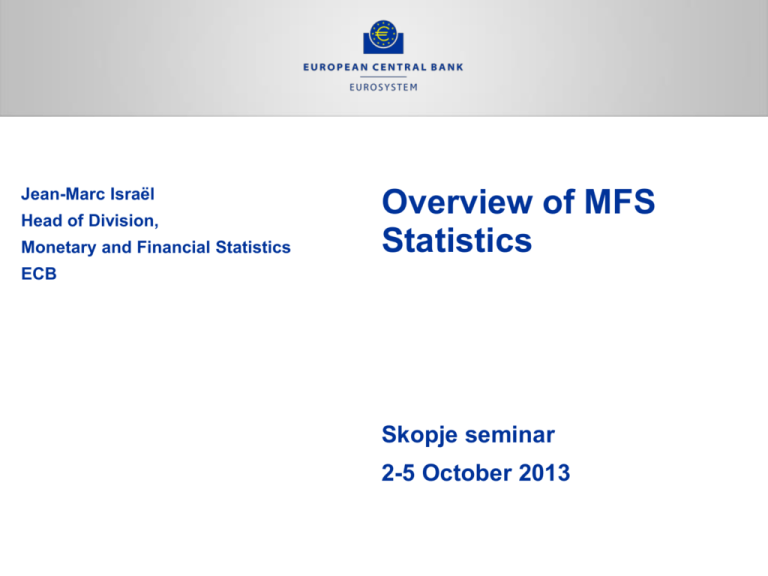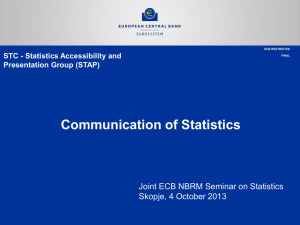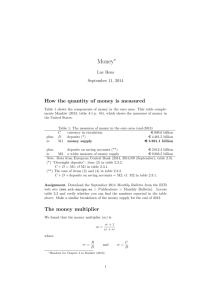Monetary and financial statistics
advertisement

Jean-Marc Israël Head of Division, Monetary and Financial Statistics Overview of MFS Statistics ECB Skopje seminar 2-5 October 2013 Contents Rubric 1 Production and dissemination of statistics – Challenges and international context 2 Overview of monetary and financial statistics 3 Case study: MFI statistics 4 Case study: MIR statistics 5 Selected results Overview of MFS Statistics 2 www.ecb.europa.eu © Statistics production and dissemination Rubric • Each country has its statistics • • • • • GDP population inflation money external balance, … • A monetary union is a single economic entity • common currency and monetary policy • free movement of persons, goods and services, capital flows • increasingly integrated (financial) markets • A monetary union needs high quality statistics and indicators to • • • • • • assess the economic developments in the whole area base its forecasts assess the transmission of monetary policy decisions on the economy analyse and assess its financial stability support the conduct of other policies (e.g. financial integration); and other functions may be looming (e.g. micro-prudential supervision) Overview of MFS Statistics 3 www.ecb.europa.eu © Decentralised statistics processing Rubric Challenges for euro area statistics (1/2) Is it not possible to simply add up national data? • Even if and when national data are - timely, - at the same frequency and - accurate enough… • concepts and definitions may still diverge (following international standards which may also need to be interpreted) • some classifications differ, e.g. intra-transactions need to be classified as “domestic” of the monetary union and, thus, allocated to SNA/ESA sectors – once asymmetry-free • institutions of the monetary union (e.g. the ECB) are residents of the union, but not of any country (even where they are located) Overview of MFS Statistics 4 www.ecb.europa.eu © Decentralised statistics processing Rubric Challenges for euro area statistics (2/2) Start from national statistics Harmonise concepts, definitions and methods to – increase comparability – enable consolidation, where appropriate – ensure the necessary coverage and level of disaggregation Cost-conscious approach – while statistics are a public good, and good policy based on good data may be invaluable for business, they have a cost – simple, automated reporting is less costly – financial transactions and positions get (more) complex – security-by-security minimises the reporting burden Central banks maintain granular datasets, e.g. a common securities database, to identify, classify, value individual assets – securities (reference data, aggregated and individual) issues and holdings – granular lending data, in part based on credit registers, are also under study Overview of MFS Statistics 5 www.ecb.europa.eu © Managing Eurosystem / ESCB statistics Rubric Harmonisation and best practices (1/3) Based on international statistical standards – System of National Accounts 1993 (and stepwise 2008) – European System of Accounts 1995 and stepwise 2010, and – IMF Monetary and Financial Statistics Manual 2000 (being updated) The contribution of ECB’s DG-S to the IMF Manual was substantial Complemented by Compilation guides and Text books common methodological definitions and concepts laid down for the euro area in Regulations (ECB/2001/13, as recast in ECB/2008/32; ECB/2001/18, as amended by ECB/2009/7; ECB/2007/8; ECB/2008/30) MFS (recast) Guideline (ECB/2007/9, amended by ECB/2008/31 and ECB/2009/23) and Manuals and/or Guidance notes All under a revision process (close to completion) Overview of MFS Statistics 6 www.ecb.europa.eu © Managing Eurosystem / ESCB statistics Rubric Harmonisation and best practices (2/3) Main ECB monetary and financial statistics manuals • Manual on MFI Balance Sheet Statistics April 2012 http://www.ecb.europa.eu/pub/pdf/other/manualmfibalancesheetstatistics201204en.pdf • Manual on MFI Interest Rate Statistics October 2003 http://www.ecb.europa.eu/pub/pdf/other/mfiintrestratestatisticsmanualen.pdf • Manual on Investment Funds Statistics May 2009 http://www.ecb.europa.eu/pub/pdf/other/manualinvestmentfundstatistics200905en.pdf • Guidance Notes on the Definitions of ‘Financial Vehicle Corporations’ and ‘Securitisation’ under Regulation ECB/2008/30 February 2012 http://www.ecb.europa.eu/pub/pdf/other/guidancenotedefinitionsfvcsecuritisation2012en.pdf • Monetary Financial Institutions and Markets Statistics Sector Manual March 2007 http://www.ecb.int/pub/pdf/other/mfimarketstatisticssectormanual200703en.pdf Overview of MFS Statistics 7 www.ecb.europa.eu © Managing Eurosystem / ESCB statistics Rubric Harmonisation and best practices (3/3) • Plus, based on experience in collecting, compiling and disseminating statistics in EU Member States • level-playing field: even-handed treatment • sharing of information across national compiling agencies and across Member States • increasing use of common tools and methods to ensure: • fair competition • similar and light reporting burden • consistency and • accuracy a set of best practices for a medium-term convergence Overview of MFS Statistics 8 www.ecb.europa.eu © Contents Rubric 1 Production and dissemination of statistics – Challenges and international context 2 Overview of monetary and financial statistics 3 Case study: MFI statistics 4 Case study: MIR statistics 5 Selected results Overview of MFS Statistics 9 www.ecb.europa.eu © The financial sector in the euro area - Overview Rubric Share of total assets by sub-sector (percentage) Assets EUR trillion Monetary Financial Institutions excluding Eurosystem (MFIs) 34.4 of which Money Market Funds (MMFs) 1.0 of which Credit Institutions (CIs) 33.2 Insurance Corporations and Pension Funds (ICPFs) Financial Vehicle Corporations (FVCs) Investment Funds other than MMFs (IFs) Total Assets 7.4 2.1 6.7 50.7 Exluding other financial intermediaries other than IF and FVC. Data as of 2012Q2, ICPF data as of 2012Q1) Euro area GDP in 2nd quarter of 2012: EUR 2.3 trillion Overview of MFS Statistics 10 www.ecb.europa.eu © Rubric E(S)CB statistics: Overview The E(S)CB collects and compiles statistics for: The financial sector and its sub-sectors (e.g. credit institutions) A list (register) of financial institutions in the EU Financial instruments (e.g. loans, securities) Outstanding amounts (e.g. balance sheet items) Transactions and growth rates (e.g. annual growth of M3) “Prices” (interest rates, yields, exchange rates) Various breakdowns (e.g. counterparty sector, maturity, currency) Overview of MFS Statistics 11 www.ecb.europa.eu © Rubric Monetary and financial statistics Monetary aggregates and counterparts: balance sheet statistics on banks and money market funds (e.g. M3, credit) Statistics on average interest rates (market interest rates, retail interest rates for deposits, loans for consumption, housing, firms) Statistics on assets and liabilities of investment funds (bond, equity, hedge funds etc.) Statistics on Financial Vehicle Corporations engaged in securitisation and banks’ securitisation June 2011 Statistics on Insurance Corporations and Pension Funds Securities issues; yield curves; financial markets price, volume and structure; payments and securities settlement statistics Overview of MFS Statistics 12 June 2011 www.ecb.europa.eu © Rubric Monetary and financial statistics Register of financial Institutions and Affiliates Database A register is key to identify the reporting population(s) (and stratify it/them) Key to identify and classify counterparts (by respondents) Key also to identify (financial) groups structures A register is essential for statistics, and its value added is even greater if it becomes multi-purposes, e.g. • ‘Close links’ for monetary policy operations • Identification of payment service institutions, and • Supporting the Single Supervisory Mechanism Overview of MFS Statistics 13 www.ecb.europa.eu © Contents Rubric 1 Production and dissemination of statistics – Challenges and international context 2 Overview of monetary and financial statistics 3 Case study: MFI statistics 4 Case study: MIR statistics 5 Selected results Overview of MFS Statistics 14 www.ecb.europa.eu © Case study ECB statistics: Rubric The ECB’s monetary policy and MFI b/s statistics Primary objective of price stability Governing Council takes monetary policy decisions based on a unified overall assessment of the risks to price stability Monetary analysis Economic analysis Macroeconomic Projections Analysis of economic dynamics and shocks Cross-checking Analysis of money and credit based on MFI statistics Full set of information Overview of MFS Statistics 15 www.ecb.europa.eu © Case study: MFI statistics Rubric Other uses of MFI balance sheet statistics: • Minimum reserves • Economic analysis • Financial stability • Financial integration • Statistical support to the ESRB Overview of MFS Statistics 16 www.ecb.europa.eu © Case study: Defining MFIs Rubric Monetary Financial Institutions (MFIs) = financial institutions (= money-issuing sector of the euro area) = central banks + resident credit institutions as defined in EU law + other resident financial institutions whose business is - to receive deposits and/or close substitutes for deposits from entities other than MFIs and, - for their own account (at least in economic terms), to grant credits and/or make investments in securities Overview of MFS Statistics 17 www.ecb.europa.eu © Case study: Defining the statistical balance sheet Rubric Overview of MFS Statistics 18 www.ecb.europa.eu © Case study: Collecting & compiling MFI b/s statistics Rubric 1. NCBs collect balance sheets from all MFIs resident in the country 2. NCBs transmit aggregated national balance sheet to ECB 3. ECB aggregates (sums) national balance sheets Euro area MFI aggregated balance sheet 4. The aggregated balance sheet is then consolidated = Netting the aggregated positions between MFIs in the euro area Euro area MFI consolidated balance sheet Euro area monetary aggregates and counterparts. 5. Main euro area aggregates are seasonally adjusted by the ECB. Overview of MFS Statistics 19 www.ecb.europa.eu © Case study: Collecting & compiling MFI b/s statistics Rubric • However aggregated data may not suffice for in-depth analysis • Detailed breakdowns are requested by users following different analytical needs, e.g. monetary analysis, monetary policy transmission, collateral management, financial stability • Statisticians need to become more proactive and responsive to ever increasing and rapidly changing needs Analytical Credit dataset based on granular loan data Overview of MFS Statistics 20 www.ecb.europa.eu © Contents Rubric 1 Production and dissemination of statistics – Challenges and international context 2 Overview of monetary and financial statistics 3 Case study: MFI statistics 4 Case study: MIR statistics 5 Selected results Overview of MFS Statistics 21 www.ecb.europa.eu © Case study: MIR statistics - Definition Rubric What is MIR? “MFI interest rates” statistical data are… • interest rates and corresponding business volumes • applied by MFIs (credit institutions) • on deposits and loans • to households (HHs) and non-financial corporations (NFCs) • resident in the euro area • denominated in euro • collected by the ESCB from MFIs Overview of MFS Statistics 22 www.ecb.europa.eu © Case study: MIR statistics - Definition Rubric “MFI interest rates” are… in great demand • cost of borrowing indicators are published since this summer (see Monthly Bulletin article in Aug. 2013 and PR in Sept. 2013) • selected (national) business volumes for publication • possible extension to better capture loans to SMEs Overview of MFS Statistics 23 www.ecb.europa.eu © Case study: MIR statistics - Breakdowns Rubric Breakdown by Sole proprietors Counterpart sector Households (HHs) Non-financial corporations (NFCs) Business coverage Outstanding amounts New business Maturity Original maturity Period of notice Initial rate fixation Purpose of the loans to HHs For consumption For house purchase For other purposes Size of the loans to Up to EUR 0.25 mn NFCs Between EUR 0.25 mn and EUR 1 mn Over EUR 1 million Collateralisation With collateral Total Special instruments Revolving loans and overdrafts Credit card credit Overview of MFS Statistics 24 (doctors, architects, dentists…) www.ecb.europa.eu © Contents Rubric 1 Production and dissemination of statistics – Challenges and international context 2 Overview of monetary and financial statistics 3 Case study: MFI statistics 4 Case study: MIR statistics 5 Selected results Overview of MFS Statistics 25 www.ecb.europa.eu © Money and credit Rubric Evolution of M3 aggregate and loans to non-MFIs excluding general government (percentage change) Overview of MFS Statistics 26 www.ecb.europa.eu © M3 dynamics by sector Rubric Sectoral contribution to annual growth rate of M3 (percentage point contribution) Overview of MFS Statistics 27 www.ecb.europa.eu © Transmission mechanisms Rubric Monetary policy transmission mechanism and financial stability Overview of MFS Statistics 28 www.ecb.europa.eu © MFI interest rate on short-term loans Rubric Nominal MFI interest rate on short-term loans to NFCs (% per annum) GR IE 2005 2006 PT IT ES euro area DE 8 7 6 5 4 3 2 1 0 2003 2004 2007 2008 2009 2010 2011 2012 Source: ECB. – Notes: Composite rate aggregated using new business volumes. Latest observation: April 2012. Overview of MFS Statistics 29 www.ecb.europa.eu ©





